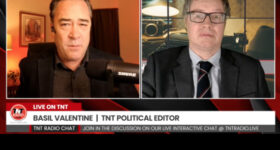 Andrew McKillop
Andrew McKillop
21st Century Wire
The big currency reset. It’s not a case of ‘if’ – it’s a case of when.
Don’t expect your provincial Secretary of Treasury or Chancellor Exchequer to warn you about what is coming around the corner, because they are either too stupid to know, or too busy covering their own backsides.
To understand where we are, it’s very important to understand how we got here (another point which bureaucrats and backers do not want the general populace to know).
A quick history lesson then…
The Opposite of Emerging is Submerging
Lulled and distracted by the antics of developed country central banks and emerging economy central banks – to constantly “pump-up the jam” and flood the economy with paper casino chips from either Fort Knox or Mount Gox, the real tectonic shift of the global economy since 2008 has been more or less ignored by financial gurus and sages. It is taken as “normal” that deflation, or disinflation is operating in the developed economies, but now we can see that rip-roaring inflation operating in the emerging economies.
Supposedly, this is ‘Muddle Through’, but since 2008 the North-South paradigm has all but dissolved – the developed OECD economies are locked in a death embrace with the Emerging economies. The developed economies are now locked into chronic globalization – exporting monetary inflation while importing cheap industrial goods, services and resources.
Since 2008 the always-promised ‘world shift’ of the economy from west to east, and from north to south has happened, but the net result is a shock. Pretending “we didn’t know” is comforting, but ultimately stupid.
This is an unstable equilibrium, or an interregnum – even a sideshow, because the current global economic context and process is the exact opposite of sustainable. Harm to both North and South is now the main impact of the post-2008 process of overreach and intense fiat paper shuffling. Listing the consequences and causes of this overreach is not easy and always open to argument, but possibly the best summary is to suggest that since 2008, ‘Ricardo’s comparative advantage‘ paradigm has been inverted. Economic and above all monetary globalization is now the path to ruin and poverty. From win-win to lose-lose. The worse it gets, expect the architects of ruin – establishment politicians, central bankers and financial pundits, to retreat into even deeper denial.
The Production Bubble That Triggers the Collapse
Another simple way to argue the global economy has overreached is that industrial and economic production capacity in the Emerging economies (EMs), starting with the BRICs, is now massively over-sized. This means the EMs can and will saturate the post-industrial, deflating North with industrial supply at every stage and opportunity as technology, design and product development throw up a new market openings everywhere. Examples like the car and cellphone, fashion wear and off-shore call center industries are relatively “classic”. All of these are already saturated with capacity – but the EMs are still adding more. Previous historical “classic examples” of this process for example included the ship building industry, but the scale paradigm has been woefully ignored.

BRAZILIAN SKILLZ: Production of top-line automobiles in Brazil has surpassed many of its ‘developed’ counterparts.
Since 2008, the process has intensified, creating an increasingly certain outlook for a forced and fiat end to the willingness of the EMs to accept the fiat currency endlessly printed to finance the deflating, de-industrializing DMs (developed economies).
This will not necessarily be a politicized process, of the type hinted at by India’s central bank governor (see http://finance.fortune.cnn.com/tag/raghuram-rajan/), due to the rapidity and scale of the crisis, but instead trigger the collapse of the current global fiat monetary order dictated by national economic self-defence and survival in the EMs.
The economic jump start of the Ricardo model, which has run riot for the last quarter-century, and went into over-drived from 2008 – will be abandoned.
Deflation/Inflation: Two Sides of the Same Bitcoin
Ricardo’s original model held sunny Portugual as a producer of cork and sherry, while rainy England could produce wine casks from its oak forests and wool from its sheep flocks. The money used in a basically resource-based exchange using then-rapidly growing maritime transport capabilities was held to be stable and gold-linked (or based). Later on, low-cost labor resources were built into Ricardo’s paradigm called “comparative advantage”. The EMs since the 1980s have played the role of resource providers while the DMs were the solvent market suppliers.
While there was a clear limit on cork, wine, oak casks and woolens supply and demand, this does not really apply to modern global fiat money and modern industrial technology. These are high gain positive feedback processes which only stop when they hit a brick wall.
The Ricardo comparative advantage model does not apply to post-1980’s globalization and super economies – like those of China and India, where industrial technology has raced ahead of infrastructure development. This is simply a bomb waiting to explode, alongside the industrial capacity growth, the EMs engaged massive growth of credit, mushroom growth urbanization, neglect of the agriculture and food sector, and turning a blind eye to rampant or even “structural” corruption. Inflation was the sure and certain result.

The results do not stop there. While inflation took off inside the EMs, with their economies producing more than they can consume, and exporting to the DMs which consume more than they produce, the EMs are also exported deflation to the developed market economies. At the same time, the emerging market economies mined out their capital bases to maintain their breakneck growth of industrial capacity.
On an almost daily basis now, the EMs are all shifting to current account deficit with the inevitable consequences of national currency devaluation, further inflation, and of course – higher interest rates.
Win-Win to Lose-Lose: Global Fiat Currency Crisis
The post-1980’s economic globalization paradigm can be called an initial ‘Win-Win’ model which eventually morphed to Lose-Lose.
The industrial nations of the DMs, which formerly benefited from the resource nations of the EMs under the previous ‘Ricardo-type’ model, are now mired in debt and de-industrialization, making it impossible for them to “grow their way out of crisis”. The EMs on their present industrial expansion path can only grow themselves into rapidly-deepening crisis.
The “money-in-the-middle” especially concerns the US dollar and its subsidiary partner, the euro, both of which are vastly overvalued fiat currencies – but against what? Almost inevitably, this will feature a big rebound for gold, playing the starring role of in this latest episode of “Canary in the Monetary Coal Mine”. From a personal standpoint, or national (for those who have any), physical gold and silver could end up providing solid protection against the exposure of a monetary reset.
Conversely, commodities are unlikely to profit on an enduring sustained basis, due to economic restructuring, re-centering and contraction being almost certain.
 Commenting on the IMF’s latest report on global capital flows since 1980, Reuters on 30 January said that while the IMF estimates net capital inflows to emerging economies as $7 trillion or more only since 2005, this was a “legacy trend” hinged on the EMs running a much higher GDP growth differential above the DMs than present. The IMF report noted that for 2014, economic growth in the BRICs will go on declining, and for Russia and Brazil, they will be less even than the GDP growth of the US and Britain. While the IMF’s economists do not allow themselves to project break-of-series change to the global economy, the process of what Gordon T. Long calls “Global collateral impairment” can easily default as the net result of apparently ‘unrelated and complex’ runaway processes.
Commenting on the IMF’s latest report on global capital flows since 1980, Reuters on 30 January said that while the IMF estimates net capital inflows to emerging economies as $7 trillion or more only since 2005, this was a “legacy trend” hinged on the EMs running a much higher GDP growth differential above the DMs than present. The IMF report noted that for 2014, economic growth in the BRICs will go on declining, and for Russia and Brazil, they will be less even than the GDP growth of the US and Britain. While the IMF’s economists do not allow themselves to project break-of-series change to the global economy, the process of what Gordon T. Long calls “Global collateral impairment” can easily default as the net result of apparently ‘unrelated and complex’ runaway processes.
This collateral impairment will inevitably trigger multi-national currency protection measures, a situation already clear in countries like Turkey, India, Argentina and other EMs.
For DMs in the North, plans are likely already underway. Will the reset feature a brand new reserve currency, or the introduction a fledgling single global, or virtual currency? If so, what will it be backed by (or maybe it won’t). It’s hard to know right now, but a shift of that magnitude could provide for the introduction of something new in the mix.
It’s a case of problem, reaction, solution, and one can assume that this Hegelian equation has already been mapped out on the back of a napkin in an executive dining floor of the one of the world leading central banks, possibly written using Christine Lagarde’s lip stick.
As a result, sacrificing GDP growth to protect the national money in the EMs will be inevitable. In turn, this will send a severe shock wave North to the DMs ,which have surfed on the latter-day version of the Ricardo paradigm for the last 30 years, and are now left unable to adapt.
The basic conclusion is that a global monetary reset is now overdue.
There will be shock waves, and haircuts too.
Brace yourself for impact, because it’s coming.
READ MORE ARTICLES BY THIS AUTHOR: 21st Century Wire McKillop Files
–














